

Smoking (combustion) Phase
1) Tobacco is combusted.
2) Smoke travels down the stem into the base.
3) Tar and ash are removed from smoke
more info
4) Smoke is then split up into hundreds of tiny bubbles.
more info
5) Smoke gradually fills chamber of tube.
Purging Phase
6) User presses stem Bypass Valve
more info
7) Air bypasses the bowl and is allowed to flow into the stem.
8) Incoming fresh air lifts the smoke column from the bottom until the pipe is cleared of smoke.
<
>
How it Works
use the < and > arrows to change
-
SHARE
Localized Dispersion
Smoke bubbles produced by this waterpipes' diffuser (perc) do not spread evenly throughout the width of the water bath.
When the smoke bubbles prefer to rise on one side of the pipe rather than the other, they tend to rise to the surface quicker (due to formation of eddy-currents in the water), thereby reducing the time that the smoke is exposed to the water. Shorter exposure times can have a significant impact on filtration (smoothness) of the water pipe.
Size and Shape Variance
Bubbles have significantly varying size and shape, causing undependable filtration.
Bubble Amalgamation
During bubble formation via this type of percolator, the bubbles have a high tendency to combine (amalgamate) into larger bubbles due to the shape and orientation of the diffuser.
So in this 5-slit diffuser scenario, rather than emitting 5 bubbles as one might think, it instead produces 1-3 bubbles.
This amalgamation behavior means bigger smoke bubbles, which significantly reduces filtration.
Typical Waterpipe Diffuser
Lets first take a look at a traditional waterpipe diffusion system that uses rectangular slots to diffuse the smoke:
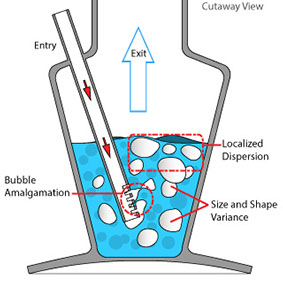
The JET Diffuser
Now lets take a look at the clog-free, filtration powerhouse within the JET Subzero Waterpipe:
Even Bubble Dispersion
Smoke bubbles are distributed evenly across the width of the water bath, ensuring maximum percolation!
This is made possible by the uniform spacing of the diffuser nozzles, and their axial orientation to the water bath, resulting in a smooth/consistent draw rather than a rough "bubbling" feeling.
Uniform Size and Shape
Bubbles are near spherical, and are very similar in size (diameter) from bubble to bubble. This ensures that each bubble of smoke gets a chance to interact with the water, resulting in an unquestionably soft, silky hit.
Bubbles stay Separate
via Retention Barrel Technology
Our patented diffuser-nozzle geometry keeps bubbles from amalgamating into larger ones by isolating the bubble-formation phase between percolator nozzles.
This ensures that the bubbles remain as small and as separate as possible, which gives the user a ridiculously smooth hit one smoking session after another.
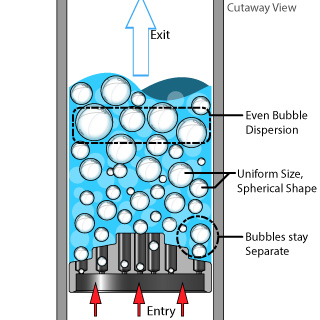
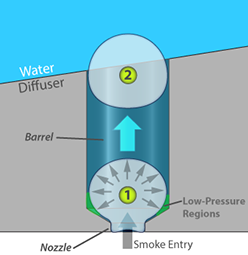
1) Formation Phase:
Smoke is pulled into the Nozzle of the diffuser where the bubble begins to form.
Low pressure regions prevent the bubble from immediately rising.
Once bubble expands to barrel diameter, it breaks free from the nozzle.
2) Retention Phase:
The smoke bubble now travels up the Barrel where it is shortly held until another formation phase begins.
Bubble Surface Area
why it matters
![]()
Top
Once produced by the water pipe diffuser, the bubble begins to rise to the surface, during which a large portion of the filtration process occurs (when smoke is completely surrounded by water). Consider the following illustration:
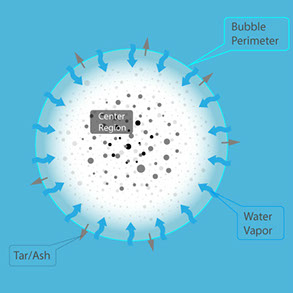
The tar, ash and non-combusted matter (contaminants) interact (shown by arrows) with the water in the following aspects:
Solid phase contaminants (ash and plant matter), become suspended in the water.
Liquid phase contaminants (tars), condense into tiny droplets and become suspended in the water.
Water Vapor evaporates into the air inside the bubble.
However these smoke/water interactions can only take place along the Smoke Bubble Perimeter (notice how the arrows must cross this boundary to “interact”). This Bubble Perimeter is quantified by the Surface Area.
This means that the contaminants in the bubble “Center Region” very rarely have a chance to interact with the water, and therefore remain unfiltered.
This means that overall Filtration (smoothness of hit) is heavily dependent upon the bubble Surface Area and the length of time that the bubble is exposed to the water.
Bubble Division
![]()
Top
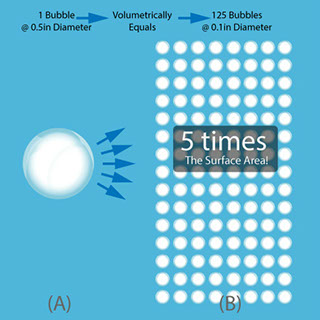
In scenario-A we have one bubble of 0.5 inches in diameter which has a given volume and surface area.
Now, if we take that single large bubble and equally split its volume up into bubbles of 0.1 inches in diameter (1/5th diameter of original), then we would have 125 of those smaller bubbles (scenario-B).
When bubbles are divided like this, the result is an increased surface area, and in scenario-B the surface area has increased by a factor of 5! (in comparison to scenario-A)
Meaning that scenario-B would filter out almost 5 times more ash, tar and non-combusted matter than scenario A!
Cyclone Technology
centrifugal ash removal
![]()
Top
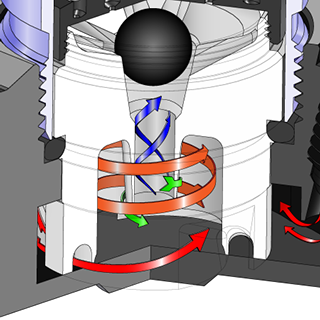
In the very heart of the JET Subzero water pipe, exists a unique form of smoke filtration. Using centrifugal force, both large and small ash particles are thrown out of the smoke prior to being diffused through the water bath, resulting in an unbelievably smooth hit.
Valved Down-stem
![]()
Top
Here at JET, we decided to make it even more interesting by adding a spring loaded bypass valve to the stem.
So now rather than pulling the bowl out to clear the pipe of smoke, all the user has to do is simply PUSH!
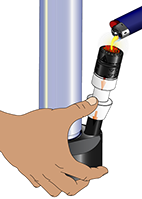 1) Burn
1) Burn 2) Purge
2) Purge
You must be 18 years of age or older to visit this site. By entering and/or accessing this Site, you are representing and warranting that you are 18 years of age or older.
If you are under 18 years of age, click here to exit now.
The term “waterpipe” is in reference to a device constructed for the sole purpose of filtering tobacco smoke/vapor via one or multiple water baths. Usage of this site is subject to our terms and conditions
